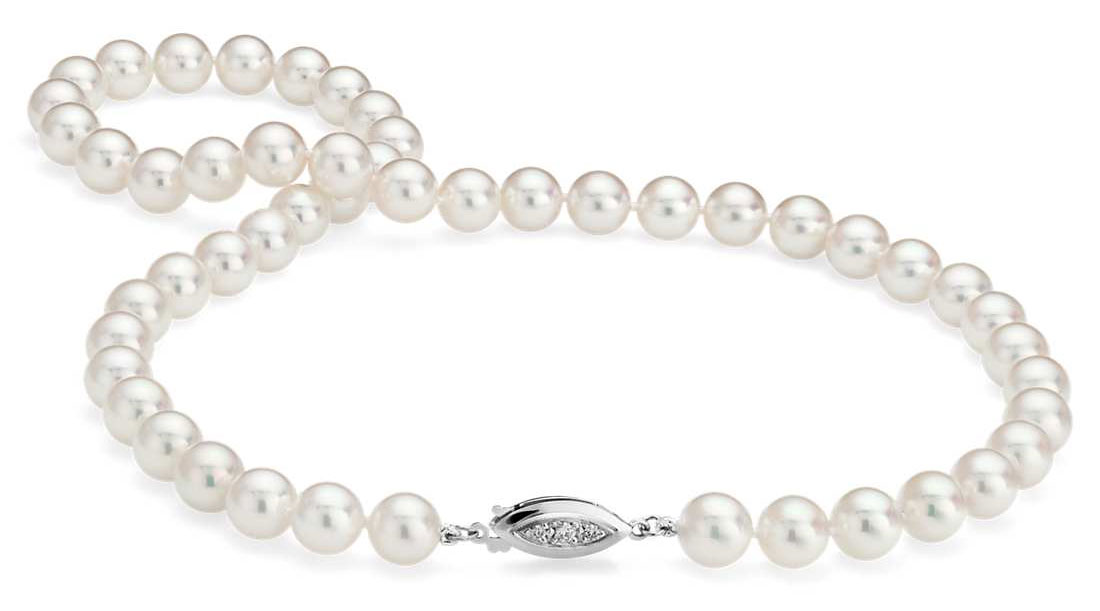A specific type of sea mollusk or oyster produces a Natural Pearl. Available in an infinite variety of colors, depending on the variety of oyster, the water temperature, the presence of minerals in the sea water, the degree of salinity and in the case of a cultured pearl, the choice of the mantle added during the culturing process.
Pearls, like any other products of nature, are never exactly alike. Although thought of as basically round, actually only about one percent is perfectly round. Pearls are available in an infinite variety of shapes from the irregularly shaped Baroque, Biwa and Mabe to the more round natural and cultured pearl.
Natural Pearl
A natural pearl is formed when an irritant, a small grain of sand of other minute object, finds its way into an oyster (not the edible variety of oyster). The irritant (nucleus) settles into the soft portion of the mollusk's body between the shell and mantle. The oyster secretes a substance, nacre, as a protective measure, surrounding the nucleus in concentric circles building up lustrous layers of nacre that results in a pearl.

Cultured Pearl
A cultured pearl is grown in a mollusk/oyster that has been surgically implanted with an irritant known as the nucleus. Cultured pearls are genuine pearls as cultivated by man, accounting for their uniformity in both size and shape.
Most of the world's cultured pearl production occurs primarily in Japan, as well as in Australia and the South Seas.
Baroque Pearl
A cultured pearl that is asymmetrical and free form in shape.
Biwa Pearl
A cultured pearl cultivated in a freshwater mussel in Lake Biwa, Japan. The term has been allowed to refer to any pearl cultivated in a freshwater mussel in Japan.
Mabe Pearl
A dome-shaped cultured pearl cultivated on the inner shell of a mollusk rather than in its body. An assemblage of a cultured half-pearl and mother-of-pearl available in round, oval and pear shapes.
South Seas / Tahitian Black Pearl
The South Seas or Tahitian Black Pearl, as it is also known, is found in the Polynesian Islands, particularly in Tahiti. These pearls are produced by black-lipped oysters in a culturization process similar to that employed to produce Japanese cultured pearls. Tahitian Black Pearl are known for their high luster and color, ranging from light to dark gray, with bluish and/or greenish overtones, and of course their larger sizes.
Abalone Pearl
A naturally cultivated pearl from an Abalone, which is a univalve mollusk.
Blemishes: Surface markings defined as scratches, blisters or indentations. Non-damaging blemishes described as spots, bumps, pits and/or wrinkles, and can affect a pearl's value. Other more serious blemishes which that can affect the durability of a pearl as well as its price include cracks, holes and chips.
Button: A dome-shaped pearl with a flat bottom.
Choker Length: A pearl necklace that is 16 to 18 inches in length.
Color: The body color or basic underlying color combined with overtones or other colors reflected in the pearls surface.
Luster: The reflective sheen that emanates from within the pearls' nacre. The thicker the layer of nacre, the deeper the luster or shine.
Mantel: The layer of thin tissue adhering a mollusk to its inner shell.
Matinee Length: A pearl necklace that is 20 to 24 inches in length.
Nucleus: A perfectly round shell taken from a mussel cultivated in the Mississippi river and introduced into the oyster around which the secreted nacre is deposited.
Opera Length: A pearl necklace that is 28 to 32 inches in length.
Princess Length: A pearl necklace that is 17 to 19 inches in length.
Rope: A pearl necklace over 45 inches in length.
Shape:
Round: perfect sphere with 2% or less distortion.
Semi-round: with 2-5% distortion.
Semi-baroque: including drop, button and oval shapes.
Baroque: usually asymmetrical or irregular shapes.
Size: The diameter of a pearl measured in full and incremental, usually half, millimeters.
Uniformity: The consistency of matching colors, sizes and shapes of multiple pearls usually in a necklace or strand of pearls.